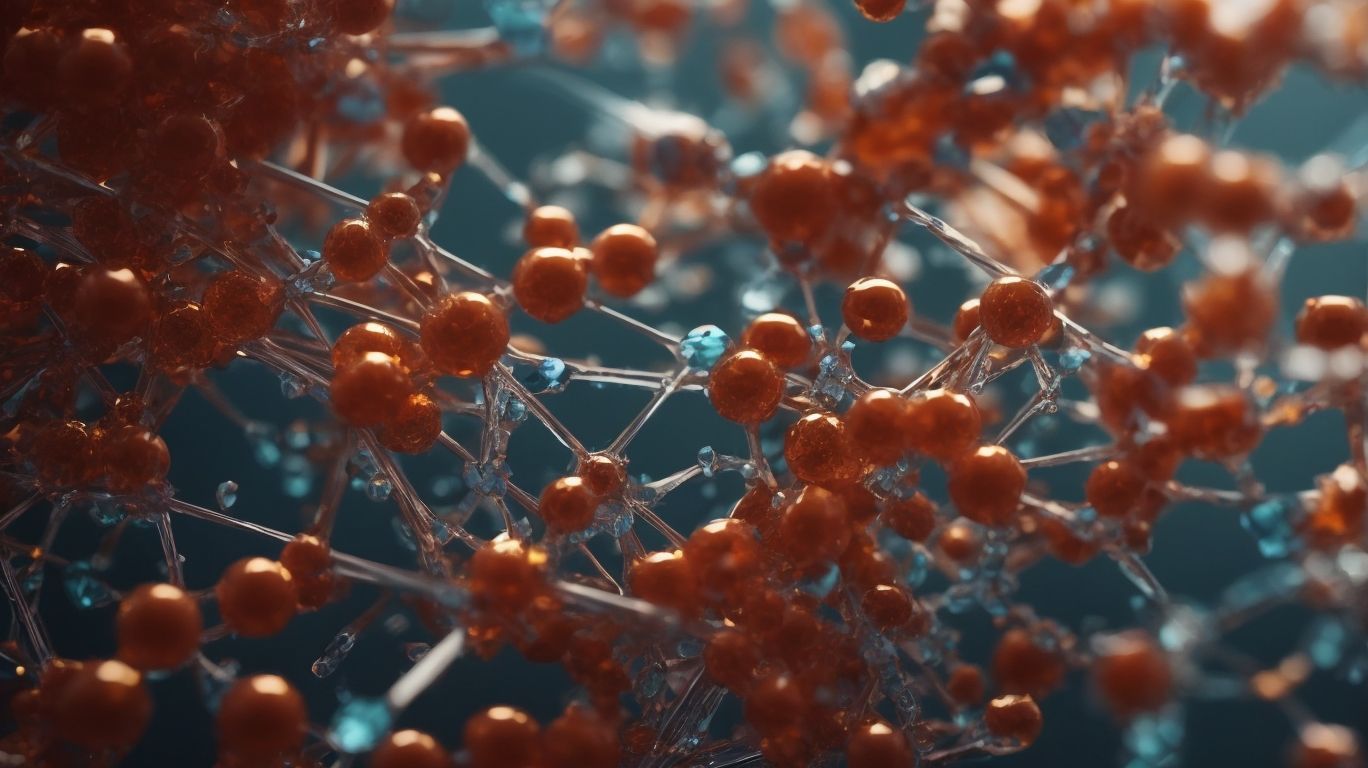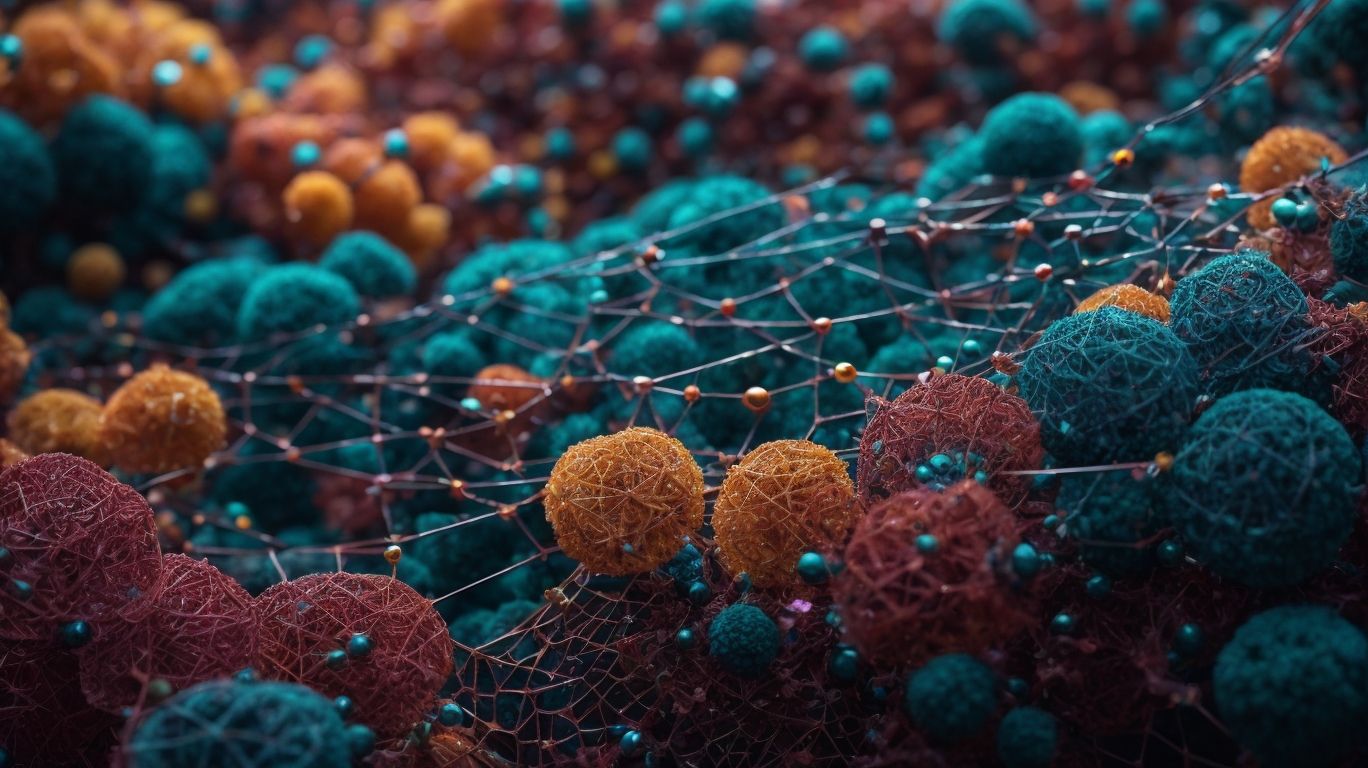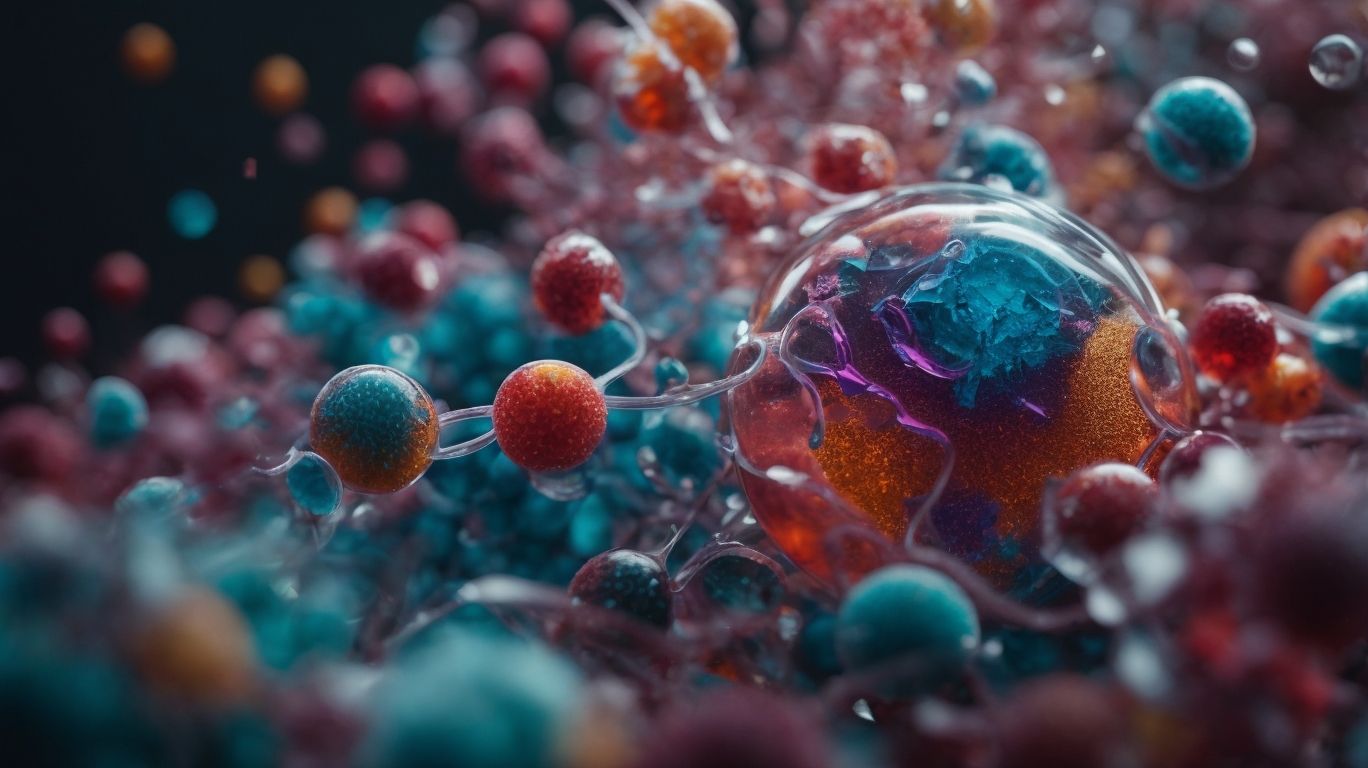Glucose is a simple sugar and one of the building blocks of life. It is the primary source of energy for our bodies and plays a crucial role in various bodily functions. This article will explore the chemical structure of glucose, its functions in the body, and its sources. Additionally, we will discuss the effects of high and low glucose levels and how it is related to diabetes.
Glucose exists in two different forms – alpha and beta. These forms differ in the orientation of the hydroxyl group attached to the first carbon atom. The most common form found in nature is the alpha form.
The chemical structure of glucose consists of six carbon atoms, twelve hydrogen atoms, and six oxygen atoms, with the molecular formula C6H12O6. These atoms are bonded together in a ring structure, with each carbon atom forming four bonds with other atoms.
Glucose is primarily known for its role in energy production. When consumed, it is broken down into smaller molecules, releasing energy that is used by our cells for various functions. It also plays a crucial role in brain function and is necessary for the proper functioning of the nervous system and muscles.
The primary sources of glucose are carbohydrates, which are broken down into glucose during digestion. Foods such as fruits, vegetables, grains, and dairy products contain varying amounts of glucose. Additionally, our bodies can also produce glucose through a process called gluconeogenesis.
Having too much or too little glucose in the body can have adverse effects. High blood glucose levels, also known as hyperglycemia, can lead to diabetes and other health complications. On the other hand, low blood glucose levels, also known as hypoglycemia, can cause weakness, dizziness, and even loss of consciousness.
Diabetes is a condition that occurs when the body is unable to produce enough insulin or cannot properly use the insulin it produces. Insulin is a hormone that regulates glucose levels in the blood. Type 1 diabetes is an autoimmune condition where the body’s immune system attacks the cells that produce insulin. Type 2 diabetes is caused by a combination of factors, including genetics, lifestyle, and obesity.
Maintaining healthy glucose levels is essential for overall health. A balanced and nutritious diet, regular exercise, and maintaining a healthy weight can help regulate glucose levels in the body. Additionally, monitoring blood glucose levels and taking medications as prescribed by a healthcare professional can also help manage diabetes. By understanding the fascinating chemical structure of glucose and its role in our bodies, we can make informed choices to maintain optimal health and well-being.
Key Takeaways:
What Is Glucose?

Photo Credits: Chemicalglossary.Net by Kyle Hall
Glucose is a fundamental source of energy for living organisms, known as a simple sugar. It is a type of carbohydrate that our bodies break down into ATP, the primary form of energy. Glucose can be found in a variety of foods, including fruits, vegetables, and grains. Its role in maintaining blood sugar levels is crucial, and it also has applications in industries such as food production and biofuel manufacturing.
Understanding what glucose is and its significance in our bodies can assist us in making informed decisions about our diet and overall health. So, the next time you are looking for a snack, consider choosing options that provide a good source of glucose to fuel your body.
What Are the Different Forms of Glucose?
Glucose is present in various forms, including monosaccharides (single sugar molecules), disaccharides (two sugar molecules bonded together), and polysaccharides (multiple sugar molecules bonded together).
Monosaccharides, such as glucose, fructose, and galactose, are the simplest forms. Disaccharides, like sucrose and lactose, are created by combining two monosaccharides. Polysaccharides, such as starch and glycogen, are made up of multiple glucose molecules bonded together.
These different forms of glucose have different effects on the body’s blood sugar levels and can be found in a variety of foods, including fruits, vegetables, grains, and dairy products.
What Is the Chemical Structure of Glucose?

Photo Credits: Chemicalglossary.Net by Michael Lewis
The chemical structure of glucose is made up of six carbon atoms, twelve hydrogen atoms, and six oxygen atoms. It can be represented by the molecular formula C6H12O6. Glucose is classified as a hexose sugar since it contains six carbon atoms. Its structure is a ring formed by the reaction between an aldehyde group and an alcohol group within the molecule. This ring structure is crucial for glucose’s role as the primary source of energy in living organisms.
Glucose is a vital component in various biological processes, including cellular respiration and the synthesis of other important molecules.
What Are the Elements That Make Up Glucose?
Glucose is made up of three elements: carbon, hydrogen, and oxygen. Its chemical formula, C6H12O6, reveals that it consists of 6 carbon atoms, 12 hydrogen atoms, and 6 oxygen atoms. These elements are arranged in a ring structure, with carbon and oxygen atoms bonded together through covalent bonds and hydrogen atoms attached to carbon atoms. This unique composition allows glucose to play a crucial role as a source of energy in the body.
How Are These Elements Bonded Together?
The chemical structure of glucose is formed through a process called glycosidic bonding. Here are the steps involved in how the elements are bonded together:
- Glucose is composed of carbon, hydrogen, and oxygen atoms.
- The carbon atoms in glucose form a ring structure.
- Each carbon atom is bonded to one oxygen atom and one hydrogen atom.
- The oxygen atom in one glucose molecule is bonded to the carbon atom in another glucose molecule, creating a glycosidic bond.
- This bonding between glucose molecules forms long chains, which are essential for the structure and function of carbohydrates in the body.
The discovery of glycosidic bonding in glucose was a groundbreaking moment in the field of chemistry. It was in the late 19th century when Emil Fischer, a German chemist, first proposed the concept of glycosidic bonds and elucidated the intricate structure of glucose. His research paved the way for further understanding of carbohydrates and their role in biological processes. Today, the knowledge of how these elements are bonded together in glucose continues to contribute to advancements in various scientific fields, including medicine, biochemistry, and nutrition.
What Are the Functions of Glucose in the Body?

Photo Credits: Chemicalglossary.Net by Daniel Sanchez
Glucose plays a vital role in the body, serving as the primary source of energy for cells and fueling essential functions such as brain activity, muscle contraction, and organ function. It is stored as glycogen in the liver and muscles and can be released when the body needs extra energy, such as during exercise or fasting.
Additionally, glucose helps regulate blood sugar levels, with the help of insulin which transports it into cells for energy. A pro-tip to keep in mind is that maintaining a balanced diet and regularly engaging in physical activity can help optimize glucose metabolism and promote overall health.
What Is the Role of Glucose in Energy Production?
The role of glucose in energy production is crucial for the proper functioning of our body. Glucose serves as the primary source of energy for our cells, providing the necessary fuel for various physiological processes. When we consume carbohydrates, they are broken down into glucose, which is then transported to cells and used in a process known as cellular respiration. This process converts glucose into ATP (adenosine triphosphate), the energy currency of our body. Without glucose, our cells would lack the fuel needed to perform their functions efficiently.
Athletes often rely on glucose as a source of energy during intense physical activities. During a marathon, a runner’s glucose levels can significantly deplete. One inspiring story involves a runner who experienced a sudden drop in blood glucose levels towards the end of a race. Feeling weak and disoriented, she consumed a glucose gel, providing her body with an immediate source of energy. With renewed vigor, she successfully crossed the finish line, highlighting the crucial role of glucose in energy production.
How Does Glucose Affect Brain Function?
Glucose plays a crucial role in brain function, providing the necessary energy for optimal cognitive performance. Here are some ways glucose affects brain function:
- Energy source: Glucose is the primary source of energy for the brain, fueling its functions and supporting the production of neurotransmitters.
- Memory and learning: Adequate levels of glucose enhance memory formation, consolidation, and retrieval, facilitating optimal learning and cognitive processes.
- Mood and emotions: Balanced levels of glucose can help regulate mood and emotional well-being, preventing mood swings and promoting mental stability.
- Attention and focus: Glucose sustains attention and concentration, allowing the brain to stay focused and perform complex cognitive tasks.
- Neurological health: Low levels of glucose can lead to impaired brain function, affecting cognitive abilities and increasing the risk of neurodegenerative disorders.
What Are the Other Functions of Glucose in the Body?
In addition to its crucial role in energy production and brain function, glucose also serves several other important functions in the body. It is involved in the synthesis of essential molecules like nucleic acids, glycoproteins, and glycolipids. Glucose also plays a vital role in maintaining osmotic balance and regulating blood pH. It acts as a precursor for the production of other sugars, such as lactose and sucrose. Furthermore, glucose is necessary for the proper functioning of certain cells in the immune system. Overall, glucose not only provides the body with energy but also plays diverse roles in various physiological processes.
In 1860, French chemist Louis Pasteur made a groundbreaking discovery when he identified glucose, a simple sugar that has since become an essential component in modern medicine. His pioneering experiments on fermentation and understanding the role of glucose in metabolic processes have paved the way for advancements in biochemistry and the treatment of various diseases. Today, glucose continues to captivate scientists, driving ongoing research into its multifaceted functions and potential therapeutic applications.
What Are the Sources of Glucose?

Photo Credits: Chemicalglossary.Net by Donald Roberts
Glucose, a vital energy source for our bodies, can be obtained from various sources. The primary source is carbohydrates found in foods like fruits, vegetables, grains, and legumes. These foods contain complex carbohydrates that break down into glucose during digestion. Additionally, the liver can produce glucose through a process called gluconeogenesis. In situations where glucose levels are low, such as during fasting or intense exercise, the body can also break down stored glycogen into glucose. Our bodies have ingenious mechanisms to ensure a steady supply of glucose for our cells to function optimally.
True story: I once had a friend who participated in a marathon race without consuming any glucose-rich foods. As a result, his blood sugar levels dropped dangerously low. Thankfully, medical personnel quickly provided him with a glucose gel, saving him from a potentially dangerous situation. This incident served as a reminder of the various sources of glucose and how important it is to maintain adequate levels, especially during strenuous activities.
What Foods Contain Glucose?
Foods that contain glucose include fruits, vegetables, grains, and dairy products.
Examples of fruits high in glucose are bananas, grapes, and oranges. Vegetables like sweet potatoes and corn also contain glucose. In terms of grains, options like rice, oats, and bread provide glucose. Dairy products such as milk and yogurt also contain glucose. Additionally, processed foods and sugary snacks can be a source of glucose. It’s important to note that while glucose is present in many foods, it’s also produced in the body through the breakdown of carbohydrates.
How Is Glucose Produced in the Body?
Glucose is produced in the body through a process called gluconeogenesis. Here are the steps involved:
- Gluconeogenesis primarily occurs in the liver and to a lesser extent in the kidneys.
- The process starts with the breakdown of non-carbohydrate molecules, such as amino acids and glycerol, derived from protein and fat metabolism.
- These molecules are converted into intermediates like pyruvate and oxaloacetate.
- Pyruvate and oxaloacetate undergo a series of enzymatic reactions to form glucose.
- The newly formed glucose is then released into the bloodstream to be used as a source of energy by various cells in the body.
This continuous production of glucose ensures that the body has a constant supply of this vital energy source.
What Happens When There Is Too Much or Too Little Glucose in the Body?

Photo Credits: Chemicalglossary.Net by Bobby Davis
When the body has an excess or deficiency of glucose, it can have significant effects. Conditions like diabetes can cause high blood sugar levels, known as hyperglycemia, which can lead to symptoms such as increased thirst, frequent urination, and fatigue. Conversely, low blood sugar levels, or hypoglycemia, can result in symptoms like dizziness, confusion, and weakness. Maintaining a balanced glucose level is crucial and can be achieved through a healthy diet, regular exercise, and monitoring blood sugar levels. Seeking guidance from a healthcare professional can also be helpful in effectively managing glucose levels.
What Are the Effects of High Blood Glucose Levels?
High blood glucose levels, also known as hyperglycemia, can have a variety of effects on the body. These include increased thirst, frequent urination, fatigue, blurred vision, and slow wound healing. If left untreated, prolonged high levels can lead to complications such as nerve damage, kidney disease, and cardiovascular problems. Therefore, it is crucial for individuals with diabetes to effectively manage their blood glucose levels. This can be achieved through regular monitoring, adhering to medication, maintaining a healthy diet, engaging in regular exercise, and managing stress levels.
A helpful tip: Consistency with medication and lifestyle modifications can greatly assist in effectively managing blood glucose levels.
What Are the Consequences of Low Blood Glucose Levels?
Low blood glucose levels, also known as hypoglycemia, can have various consequences on the body. These consequences may include dizziness, confusion, weakness, and even loss of consciousness. In severe cases, hypoglycemia can lead to seizures or coma. It is important to promptly address low blood glucose levels by consuming foods or drinks rich in glucose, such as fruit juice or candy. This is especially important for individuals with diabetes, as they need to closely monitor their glucose levels and take appropriate measures to prevent hypoglycemia. Consistently planning meals and managing medication can help maintain healthy glucose levels and avoid the consequences of low blood glucose.
How Is Glucose Related to Diabetes?

Photo Credits: Chemicalglossary.Net by Richard White
Glucose plays a vital role in diabetes, as it is closely linked to blood sugar levels and the functioning of insulin. Understanding this relationship is crucial for effectively managing the condition.
Here are some important steps to consider:
- Glucose Metabolism: In diabetes, the body struggles to regulate glucose levels due to insulin resistance or insufficient insulin production.
- High Blood Sugar: Elevated glucose levels in the bloodstream can lead to symptoms such as increased thirst, frequent urination, and fatigue.
- Complications: Prolonged high blood sugar can cause damage to organs and nerves, resulting in complications like heart disease, kidney problems, and nerve damage.
- Monitoring: Regularly checking blood sugar levels allows individuals with diabetes to adjust their diet, exercise, and medication accordingly.
- Management: Proper management involves maintaining a balanced diet, engaging in regular physical activity, taking prescribed medications, and monitoring blood sugar levels.
Pro-tip: Collaborating closely with healthcare professionals and staying informed about diabetes management can greatly improve overall health and well-being.
What Is Type 1 Diabetes?
Type 1 diabetes is a chronic autoimmune disease where the immune system attacks and destroys the insulin-producing cells in the pancreas. This leads to the body’s inability to produce insulin, a hormone necessary for glucose to enter cells and provide energy. The exact cause of type 1 diabetes is unknown, but it is believed to involve genetic and environmental factors. Symptoms of this condition include:
- excessive thirst
- frequent urination
- unexplained weight loss
- fatigue
Treatment for type 1 diabetes involves:
- insulin therapy
- blood sugar monitoring
- maintaining a healthy lifestyle
This disease is typically diagnosed in childhood or adolescence and requires lifelong management.
What Is Type 2 Diabetes?
Type 2 diabetes is a chronic condition that occurs when the body becomes resistant to insulin or doesn’t produce enough insulin. This results in high levels of glucose in the blood. While it typically develops in adulthood, it can also affect children. Risk factors for this condition include obesity, physical inactivity, genetics, and poor diet.
Symptoms may include increased thirst, frequent urination, fatigue, and blurred vision. Treatment involves making lifestyle changes, such as regular exercise and a healthy diet, as well as taking medications to manage blood sugar levels. Maintaining a healthy weight and monitoring blood sugar levels can help prevent or manage type 2 diabetes.
The discovery of insulin in the 1920s revolutionized the treatment of diabetes, particularly type 1 diabetes. It allowed for better management of blood sugar levels and improved the quality of life for those living with the condition. Today, ongoing research continues to uncover new insights into the causes and treatment of type 2 diabetes, with the goal of finding more effective therapies and ultimately a cure.
What Are the Symptoms of Diabetes?
Common symptoms of diabetes include:
- excessive thirst
- frequent urination
- unexplained weight loss
- fatigue
- blurred vision
- slow-healing sores or wounds
- frequent infections
These symptoms can vary depending on the type of diabetes and the individual. It’s important to note that some people with type 2 diabetes may not experience any noticeable symptoms initially. If you are concerned about the question “What Are the Symptoms of Diabetes?”, it is crucial to consult with a healthcare professional for proper diagnosis and management. Regular check-ups, maintaining a healthy lifestyle, and adhering to prescribed treatment plans are essential for managing diabetes effectively.
How Can We Maintain Healthy Glucose Levels?

Photo Credits: Chemicalglossary.Net by Brandon Taylor
Maintaining healthy glucose levels is crucial for overall well-being. Here are some steps to help you achieve this:
- Eat a balanced diet: Incorporate whole grains, lean proteins, fruits, and vegetables into your meals.
- Exercise regularly: Physical activity helps regulate glucose levels and improves insulin sensitivity.
- Avoid sugary beverages: Opt for water, unsweetened tea, or black coffee instead.
- Manage stress: Stress can impact glucose levels, so it is important to practice relaxation techniques like meditation or yoga.
- Monitor your blood sugar: It is important to regularly check your glucose levels and seek guidance from a healthcare professional.
True story: John, a diabetic, diligently followed these steps and successfully maintained healthy glucose levels. With a balanced diet, regular exercise, and stress management, he was able to lead a fulfilling and active life.
What Are the Dietary Recommendations for Maintaining Healthy Glucose Levels?
To ensure healthy glucose levels, it is crucial to follow specific dietary recommendations. These include consuming a well-balanced diet with an emphasis on whole foods such as fruits, vegetables, lean proteins, and whole grains. It is also important to limit the intake of processed foods, sugary beverages, and refined carbohydrates. Portion control and maintaining regular meal times can also help regulate glucose levels. Additionally, incorporating regular physical activity into one’s routine can improve insulin sensitivity and promote healthy glucose metabolism.
It is recommended to seek guidance from a healthcare professional or registered dietitian for personalized dietary recommendations based on individual health needs.
In the past, when sugar was considered a luxury, maintaining healthy glucose levels was not a concern for most individuals. However, as sugar production and consumption increased, so did awareness of its potential health impacts. In the early 20th century, researchers began studying the effects of sugar on blood glucose levels and its connection to conditions like diabetes. This led to the development of dietary recommendations aimed at promoting healthy glucose levels and overall well-being.
Today, with a better understanding of the importance of balanced nutrition, individuals have access to resources and guidance for maintaining optimal glucose levels.
What Are the Lifestyle Changes That Can Help Maintain Healthy Glucose Levels?
To maintain healthy glucose levels, certain lifestyle changes can be implemented. These include:
- Regular exercise: Engaging in physical activity can help improve insulin sensitivity and regulate blood sugar levels.
- A balanced diet: Consuming a diet rich in whole grains, lean proteins, fruits, and vegetables can promote stable glucose levels.
- Portion control: Monitoring portion sizes and avoiding overeating can prevent spikes in blood sugar.
- Limiting sugary foods and beverages: Reducing the intake of sugary snacks and drinks can help regulate glucose levels.
- Stress management: Implementing stress-reducing techniques such as meditation or deep breathing exercises can support healthy glucose regulation.
- Sufficient sleep: Prioritizing quality sleep can aid in maintaining stable glucose levels.
- Regular monitoring: Monitoring glucose levels and working closely with healthcare professionals can help identify and address any issues promptly.
Frequently Asked Questions
What is the significance of the chemical structure of glucose in the building blocks of life?
Glucose, a simple sugar, plays a crucial role in providing energy for cellular activities and is an essential component of carbohydrates, one of the four main macromolecules that make up living entities.
How do carbohydrates contribute to the functioning of living organisms?
Carbohydrates serve as the primary source of energy for cells, facilitating various chemical processes and metabolic reactions that sustain life. They also play a role in providing structural support and aiding in cellular communication.
How do lipids contribute to the structural basis of cells?
Lipids, also known as fats, play a vital role in building cell membranes, providing insulation, and storing energy for future use. They also help in regulating cellular activities and maintaining proper functioning of the body.
What is the significance of proteins in living organisms?
Proteins play a diverse range of roles in living organisms, such as tissue building and repair, acting as enzymes, and facilitating chemical reactions. They are crucial for the proper functioning of cells and are involved in various biological processes.
How do nucleic acids contribute to the genetic information of living organisms?
Nucleic acids, specifically DNA and RNA, hold the genetic information that guides the development and functioning of living organisms. They contain instructions for building and maintaining an organism, and assist in executing those instructions.
Can artificial intelligence be used to study the chemistry of life?
Yes, advancements in technology have enabled scientists to use artificial intelligence to study complex chemical reactions and processes in living organisms. This has provided valuable insights into the building blocks of life and their functions.
